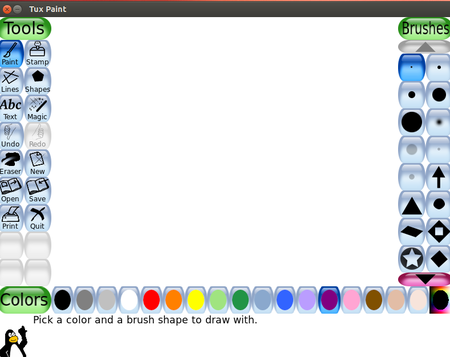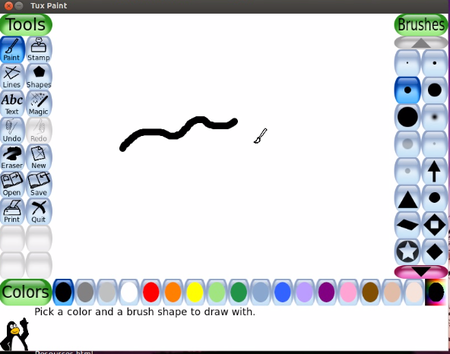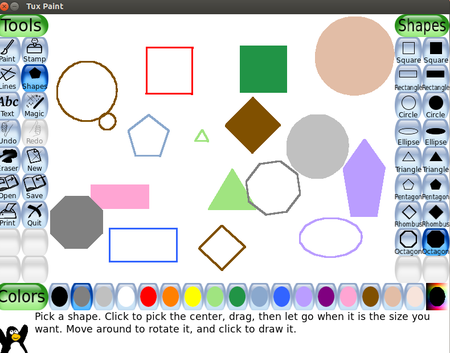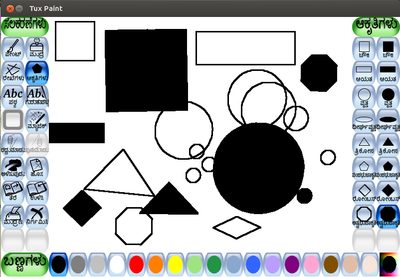Learn Tux Paint
Introduction
ICT Competency
- Tux Paint is a raster graphics editor (a program for creating and processing raster graphics). Raster graphics (also known as a bitmap graphic editor) is simpler than vector graphics editor such as Inkscape, and easier for students to learn initially. It is more relevant to graphics created as photographs or digital drawings. The vector graphic editor stores information of the image in mathematical format and is more relevant to graphics created by design software.
Educational application and relevance
Tux Paint is a free and open source graphics editor computers with different operating systems. It features a simple interface and a fixed drawing area with access to previously made images using icons. Tux Paint is equipped with a lot of tools designed to excite young learners, from cartoon mascots who encourage them to use the software to cartoon sound effects.
Version
- Tool Version
The Tux Paint version – 0.9.21 Tux Paint is part of the Ubuntu distribution (in the training). This can be opened from Applications → Education → Tux Paint
Configuration
It is in_built with custom distribution
Overview of Features
- Toolbox, containing the various basic tools and application controls (undo, save, new, print)
- Canvas, where the images are drawn and edited
- Color palette, where colors can be chosen (when applicable to the current tool)
- Selector, providing various selectable objects (e.g., brushes, fonts or sub-tools, depending on the current tool)
- Information area, where instructions, tips and encouragement are provided
You can view detailed features here
Other similar applications
Similar applications include GIMP, MyPaint, Kolorpaint
Development and community help
1. Tux paint help document is Here
2. Tux paint tutorials are Here.
Working with the application
Functionalities
 Image Image
|
 Image Image
|
| Step 1-When we open the Tux Paint we will get window like this. This window or main screen contains following sections:
left side:Tool bar Tool bar contains drawing and editing controls. Middle:drawing convas The largest part of the screen, in the center, is the drawing canvas. Right Side: Selector Depending on the current tool, the selector shows different things. e.g., when the Paint Brush tool is selected, it shows the various brushes available. When the Rubber Stamp tool is selected, it shows the different shapes you can use. Lower: Colors A palette of available colors are shown near the bottom of the screen. Bottom: Help Area At the very bottom of the screen, Tux, the Linux Penguin, provides tips and other information while you draw. |
Step 2-The Paint Brush tool lets you draw freehand, using various brushes (chosen in the Selector on the right) and colors (chosen in the Color palette towards the bottom).
As you draw, a sound is played. The bigger the brush, the lower the pitch. |
 Image Image
|

|
| step 3-An example of filled and unfilled shapes. | step 4-'Drag and drop functionality using a mouse-To Draw shapes in Tux paint, Click on "Shapes" and then in right side, select any shapes which required. For ex: select rectangle shape. draw rectangle with drag (press left click and keep pressed) and drop (release left click), if u didn't keep press mouse and release, it will take not place here and keep moving with changes. This required to complete shapes drawing. |
File formats for creation
The files created are stored in the /home/.tuxpaint/saved folder, in the 'png' format. To open the .tuxpaint folder, you may need to select the 'view hidden' files in the /home folder on Ubuntu. The file name will begins with 'year+month+date' in YYYYDDMM format, followed by a serial number.
Saving the file
Steps For Saving File
1. Go to File menu select Save option
2. give the name for the file
3. It can be saved in *.ora , *.jpg , *.png and *.jpeg
Export and publishing files
Steps For export and publishing File
1. Go to File menu select Export option
2. give the name for the file
3. It can be saved in *.ora , *.jpg , *.png and *.jpeg
Advanced features
1.Multi-Platform
2.Simple Interface
3.Entertaining Interface
4.Drawing Tools
5.Commands
6.Accessibility and Parental and Teacher Controls
Installation
1.From software center
Applications → Ubuntu Software Center → search as “Tux Paint” → Click on Install. (If it asks any authentication, Enter your Ubuntu login password.)
2.From terminal-
Open terminal by clicking (ctrl+Alt+T), Once window page is open, in front of dollar($) symbol just type below command. sudo apt-get install tuxpaint
Now, Enter your ubuntu login password(it will be hide) then press Enter.
3.Web download-
Follow the below link for Installing through web, but again it will take you through software center. https://apps.ubuntu.com/cat/applications/precise/tuxpaint/
The application on mobiles and tablets
currently there is no mobile app for Tux Paint
Ideas for resource creation
- It is easy to use Tux Paint to create simple drawings. These drawings can be a combination of what you can draw, combined with the 'stamps' or images already available in the application. Thus image/graphics resources can be created with Tux Paint. These images can be inserted in documents to create picture essays.
- The files saved by Tux Paint are available in your home folder, under the sub folder /.tuxpaint/saved
- The "." preceding the tuxpaint makes this folder 'hidden'. To unhide and open this folder you can do CTRL H when you have opened your home folder. You can then see all hidden folders. You can copy these files to any other folder you want.
- It is also possible to create simple animations in Tux Paint. You can create a series of drawings, with small modifications as required. You can sequence these drawings to show one after another. You can then 'play' the slides for to create an animation.
